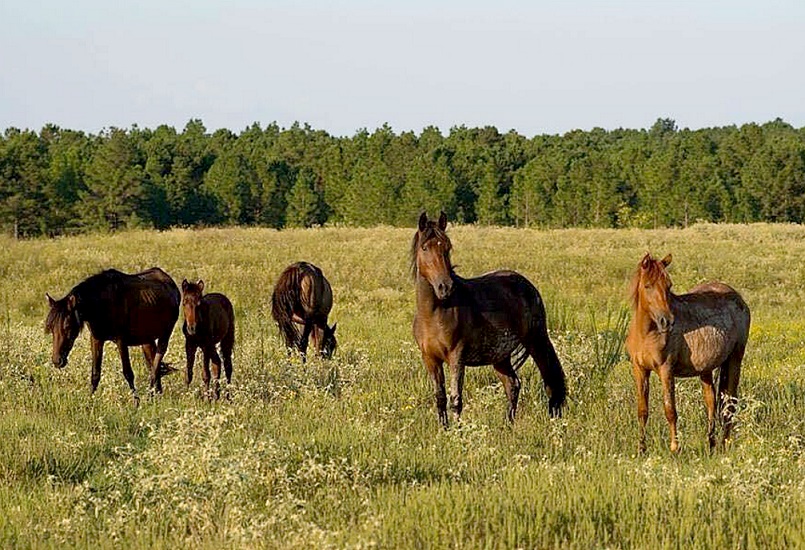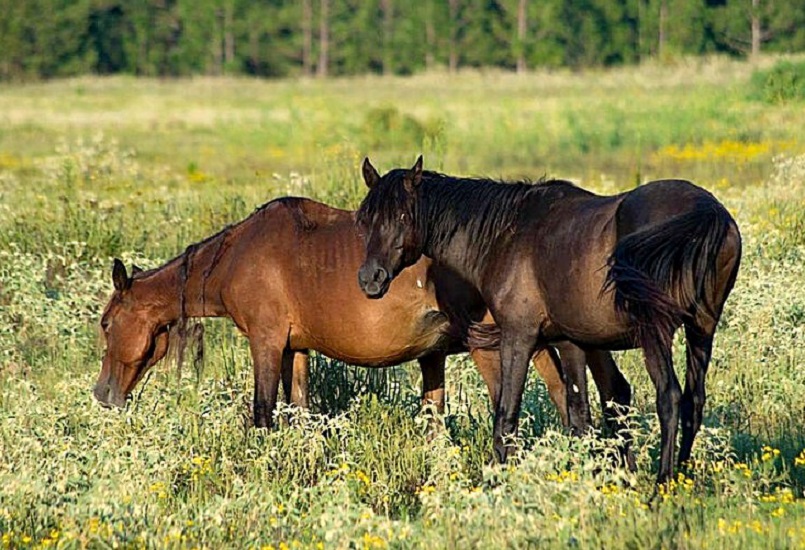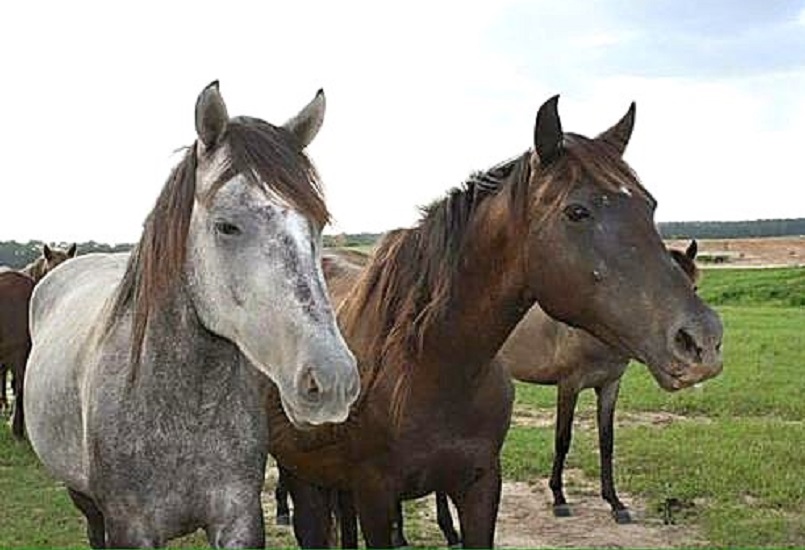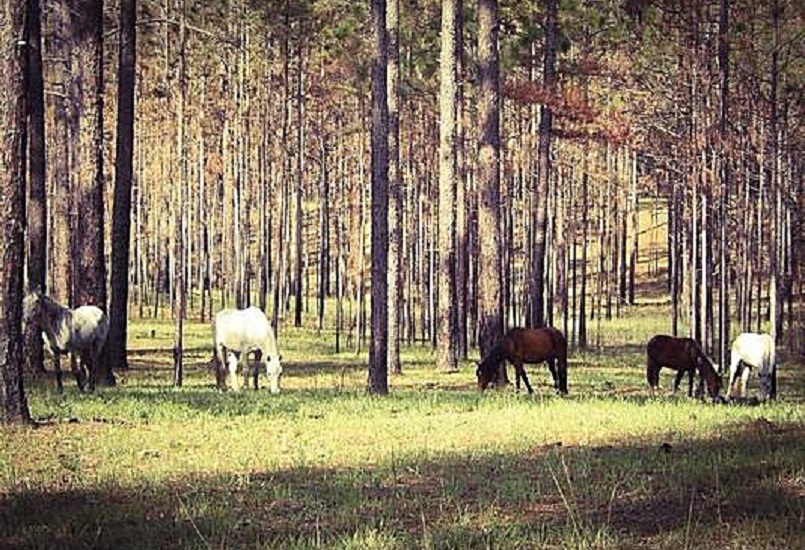The U.S. Army is in the process of removing wild horses from ranges and pine forests that the horses have inhabited for many generations.
There are two things seriously wrong with this:
First, when these unique Louisiana wild horses are removed, their role as part of the area's natural environment comes to an end; and the horses themselves become something other than what they were as wild horses. The same thing happened to the American Indians when they were removed from the land, and forced to become something different. What they were as a part of their natural environment was lost forever.
Further, when the wild horses are gone, so will be their historic role as part of the heritage of the region. Wild horses have always held a special place in the hearts of many Americans. They are icons of our American heritage.
Second, despite the fact that Ft. Polk Commanding General Gary Brito has said the removal of the horses is to be humane, in actuality, the Army has shown no serious concern, and will shoulder no responsibility, for what happens to the horses after they are removed. That very likely means the horses will end up going to a cruel death at slaughterhouses in Mexico and Canada.
The Army's Joint Readiness Training Center [JRTC, Ft. Polk] encompasses approximately 150,000 acres (240 sq. mi.) in west-central Louisiana, bordering parts of the Kisatchie National Forest (604,000 acres in totality), and partially interspersed with private holdings and state wildlife management areas. The JRTC conducts simulated warfare exercises, where a resident "enemy" army battles visiting military units (some from foreign countries).
Surprisingly for some, the region has been home to hundreds of wild horses. Much of the JRTC and surrounding lands are covered in piney forests and rangeland where the horses have lived and freely roamed for the better part of a century, and possibly much longer.
To really understand the situation, it is extremely important to realize that there are two distinct major groups of horses:
There are the truly wild horses; numbering probably at least a couple of hundred. They are uniform in coloration, with no whites or grays among them. They are subdivided into smaller bands, each led by a lead stallion with mares, foals, colts, and fillies. They are localized close to the Peason Ridge "hot" training area where weapons are fired. When activity starts in the Peason Ridge area, the horses make themselves scarce in the forest.
And, there is another group of horses on the main Ft. Polk area, approximately twenty miles south of Peason Ridge. Training areas on the main Fort Polk area are also occupied by horses. But, they are less disturbed by the army's training activities. These horses are a mix of wild horses (some similar to the wild horses on Peason Ridge), some abandoned horses, and horses born free-roaming and wild to mares from the various groups. They have become more acclimated to the commotion of the army's activities.
Failing to understand the distinction between the groups of horses has led to the incorrect perception that they are all abandoned (trespass) horses.
Not only are there wild horses on the main post at Fort Polk and at Peason Ridge, they range throughout parts of the Kisatchie National Forest. Horse advocates have been working to preserve and protect them. That's not to say that the abandoned horses (a small minority of the horses) are not also a matter of serious concern. All of the horses deserve to be kept from harm's way and from going to slaughter. See pictures of the two groups of horses below.
Ft. Polk spokespersons have avoided any recognition of the truly wild horses. They seem to have intentionally fostered misconceptions and confusion by focusing media attention on the horses on and around the main post at Ft. Polk (that don't seem wild because they have become acclimated, and because they no doubt include a number of abandoned horses).
This has made attempts by horse advocates to enlist the public to help preserve and protect the environmentally and culturally valuable wild horses of Louisiana more difficult. Ft. polk propaganda calls the horses "trespass" horses. "Trespass" means illegally coming onto the land. The label is certainly usable to demean some recently abandoned horses. But, what about the vast majority of the horses: those that are truely wild or have reverted to the wild state, and those wild horses that were born into wild bands on JRTC lands. The truly wild horses they have called "trespass horses in their progeny". It fits into their propaganda scheme, but how absurd in reality.
Soldiers are injured and killed in accidents at Ft. Polk, but never has any such accident involved the horses. Frankly, Ft. Polk has underhandedly cited anything, no matter how far-fetched, in hopes of justifying to the public their compulsion, driven by only a few, to "eliminate" the horses. But, sometimes the horses are present on the "Geronimo" parachute drop zone on the main post. And, even though it has never happened before, there could be a collision between a "jumper" and a horse. Since trainees can surely do without such distractions, it does make sense to take precautions. But, wouldn't it be OK just to exclude the horses from the places where they may, from time to time, be a nuisance.
One young woman, who lives on the main post, summarizes the feeling of many locals:
"I feel upset about them being removed. They are so beautiful! They don't harm anyone, and they were here before us. They bring joy to a lot of folks here. It's what Fork Polk is known for!"
Horse advocates would like for the Army to establish protected sanctuaries for the horses where the number of horses could be ethically and humanely managed. This would keep the horses safe from going to slaughter, which many, with good reason, believe would be their fate otherwise. Any such operation could be funded and run by non-government organizations, sparing the Army an added expense which they say they cannot afford. If necessary, those organizations could manage and carefully oversee adoption of horses to reduce the population.
Neda DeMayo [nationally known wild horse expert: President, Return to Freedom (Wild Horse Preservation, Education & Sanctuary); and Founder, American Wild Horse Preservation Campaign, a coalition of organizations dealing with current wild horse crisis issues] advises:
"In light of the thousands of wild horses and burros that the federal government wants to remove from the range in Nevada and elsewhere, it would be irresponsible for the Department of Defense to move forward without a long-term, humane management plan for the Ft. Polk horses. We respectfully urge the Army to partner with local organizations to create and implement a humane management plan, using safe, proven fertility control, to reduce the number of horses over time."
Ft. Polk has recently acquired 45,000 acres between the Ft. Polk main post and Peason Ridge. A Ft. Polk ranking officer said the Army will need to use all the land, and the training units will be larger. However, a sizable tract within the acquired land is to be held in reserve for ten years when the timber will be harvested. And the size of training units have been becoming smaller, not larger. The training areas formerly used (for training troops for Vietnam and Desert Storm) are more than adequate for the foreseeable future. Of course, the actual need could change abruptly, and other arrangements would have to be made for the horses. But, Ft. Polk has tolerated them for many decades. They ought to be able to tolerate them a little longer while reasonable accommodations can be made for them, and not continue to rush into a situation that can only end very badly for the horses.
Late in 2016, Ft. Polk starting putting horses into the hands of a Texas humane society that claims they can take them and get them adopted. If the adoptions are to reliable people only, and none of the horses are allowed to go to slaughter (out the back door, so to speak), it is highly unlikely that their goal can be anywhere close to being realized. That's why horse advocates are so concerned. They can't see how slaughter will not be the outcome for most of the horses, especially the wild ones.
Putting it simply from the point of view of those hoping to preserve and protect the horses: the JRTC has no plan addressing the likelihood that the horses, however unintentionally, will be sucked into the horse slaughter "pipeline", a grisly, horribly cruel, and well organized machine that eagerly and impatiently waits to grab unwanted horses, domestic or wild.
The horses have been appreciated by many, including locals, visitors to the area, and Army personnel alike for many decades. Some have maintained that all of the horses lend an air of realism to the manufactured 3rd World setting, and an element of unpredictability typical of authentic military operations. In fact, a former JRTC commander, General Samuel Thompson, wrote in May, 1999:
"I don't want to lose those herds!"
Please let the Army know you want the wild horses to stay in the Ft. Polk/ Kisatchie area, humanely managed or placed in proper care only when necessary, and that you want all of the horses to be kept from slaughter.
Contact information for the Ft. Polk Public Affairs Office is:
7073 Radio Rd, Fort Polk, LA 71459
Phone: (337) 531-7203
Fax: (337) 531-6014
eMail:
usarmy.polk.imcom.mbx.pao-public-response@mail.mil
And please, copy any communication sent to Fort Polk to:
horses@humaneheart.org
for a record that will be supplied to Ft. Polk Commanding General Gary Brito.
CLICK for ADDENDUM (at bottom) with information on:
horse slaughter, BLM problem adopting wild horses, etc.
_____________________________
Ft. Polk / JRTC Wild Horses / Peason Ridge Training Area - 1:

Ft. Polk / JRTC Wild Horses / Peason Ridge Training Area - 2:

Ft. Polk / JRTC Wild Horses / Ft. Polk (Main) - 1:

Ft. Polk / JRTC Wild Horses / Ft. Polk (Main) - 2:
 _____________________________
Return to Top of Page
_____________________________
Return to Top of Page
ADDENDUM
1. What You Need To Know About The Horror Of Horse Slaughter
2. Unlikelihood That The Horses Will Be Properly Adopted To Good Homes
3. A Little History
1. What You Need To Know About The Horror Of Horse Slaughter
Why is slaughter so devastatingly cruel?
Slaughter is a convenient way for excess horses to be eliminated. Many breeders intentionally over-breed. About 100,000 horses per year go to slaughter. The propaganda here is that animals are better off dead than in the hands of those who neglect or abuse them. Slaughter proponents say something like, "If people in other countries consume horse meat, and if slaughter is humane, then what's the problem?"
There is no humane horse slaughter. Starting with the means of transportation: Horses are fractious animals that want to flee danger. When jammed together in a frightening situation, they fight. Transporters have poked out their eyes to make them manageable. After a journey of hundreds of miles into Mexico and Canada where the slaughterhouses are, and without having been fed or watered, the horses are immobilized. The slaughter line is required to move fast, and the workers are men who can get no other employment. Some are rejects from society that violently take their frustration out on the horses. Horses are in panic as they go to slaughter, seemingly knowing their fate. In Mexico, horses are prevented from struggling by cutting into the spine with a dagger. In Canada, they are shot in the head with a small caliber bullet. Neither, kills the horse. In other slaughterhouses in these countries where horses are brought from the United States to be slaughtered, a pneumatic (high pressure air) gun is used. It has a "captive" bolt that pops out and is supposed to strike the horse in the forehead. But, the horse's head is not effectively restrained, and it may take multiple shots to sufficiently immobilize the horse. The horse is painfully wounded with each shot, as its head is lacerated and its skull is crushed. Often, the horse enters the slaughtering procedure only stunned, but not unconscious. The horse dies in circumstances which can only be described as torture.
Horses, we often hear, have a special place in the hearts of people who want them respected as animals upon whom we have depended for our progress, and which are integral to our American heritage. Those people want our horses to be treated with kindness, not brutally slaughtered to satisfy the palates of wealthy, self-absorbed individuals in Belgium, France, Japan, and elsewhere.
Please use these links to read the details by Habitat For Horses's Jerry Finch:
Part 1:
The History
Part 2:
The Process
Part 3:
The Problem
Part 4:
The Arguments
Part 5:
The Money Trail
There are quite a few Internet pages having to do with horse slaughter.
2. Unlikelihood That The Horses Will Be Properly Adopted To Good Homes
Here's what Ft. Polk intends: Without any attempt to mark or trace the horses, they say they will give horses to charitable animal rescue organizations. Failing that, they will give the horses to anyone who wants them, and trust them to humanely care for the horses.
That's what they say. However, they have been in communication, not only with charities, one in particular that says they can take all of the horses (a doubtful prospect), but also with known "kill buyers" who channel horses into the slaughter "pipeline". Contrary to what Ft. Polk says publicly, one man gave written testimony that Ft. Polk offered him, as an individual, all of the horses.
The Bureau of Land Management [BLM], the Department of the Interior agency charged with the protection of wild horses on their wild horse ranges, is holding more than 44,000 horses and more than 1,000 burros they have removed and are keeping in holding facilities awaiting adoption. Even though they have taken significant precautions, including permanent, unalterable and unmistakably visible freeze-brand markings on the horses they adopt out, their horses still end-up at Mexican and Canadian horse slaughterhouses. Too often, adopters find their good intention of adopting a "mustang" was unrealistic. And, of course, there are "adopters" who's intention from the start is selling horses at auction, where there is a very high probability that the purchaser will be a "kill buyer" who channels the horse to the slaughterhouse.
If the BLM, with their precautions, can't keep horses out of the slaughter "pipeline", Ft. Polk, with no serious precautions, certainly won't be doing it.
Because of drought conditions in the West, and the large numbers of wild horses which have been taken off the land, and those already in sanctuaries that need to be provided for, it is not likely that wild horses taken off JRTC lands will have a rosy future. In fact, slaughter is the likely outcome.
3. A Little History
According to some locals, the soldiering exercises on JRTC lands have coexisted with the wild horses as far back as they can remember (before WWII).
Army training began in the area, circa 1941, before our entry into World War II. We still had mounted cavalry. General George Patton, an Olympic equestrian competitor in 1912, was a mounted cavalry officer in Hawaii before participating in the "Louisiana Maneuvers" in 1941. The maneuvers tested tanks against anti-tank weapons and 32,000 cavalry horses, including the 10th Cavalry "Buffalo Soldiers". The horses actually won the first round. Incidentally, General Brito, the Ft. Polk Commander, comes from the same Hawaiian infantry that trained at Ft. Polk in the early years of its existence. Near the end of the war, some of Patton's men, in cooperation with some of our German adversaries, risked their lives behind the lines to save the famous Lipizzaner Stallions, the grand white performing war horses of Austria, and champion Polish Arabians, from the advancing Russian Army. It was expected, as they had done before, that the food-deprived Russian "liberators" would have slaughtered and eaten the horses.
One of the American soldiers who put himself at considerable risk, Colonel Charles "Hank" Reed said of their harrowing exploits, "We were so tired of death and destruction. We wanted to do something beautiful."
Horse-lovers everywhere, please "do something beautiful", and help save the remarkable wild horses of Louisiana.
_____________________________
Return to Pictures
Return to Top of Page